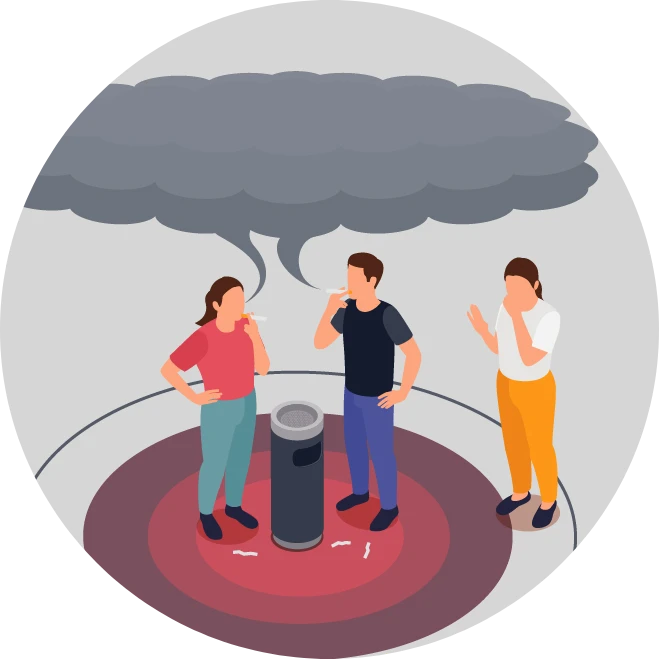Blue-Collar Workers and Cancer
Compared to other professions, blue-collar workers in industries like construction, manufacturing, and agriculture have higher rates of several types of cancer, including lung cancer, bladder cancer, mesothelioma, and others. The level of risk for these workers varies by industry and their exposure to hazardous materials like asbestos, benzene, and tobacco smoke. Even though significant advancements have been made in occupational health and safety regulations, these protocols are often not followed properly, leaving many workers still at risk of exposure to carcinogens and eventually developing cancer.
Common Cancer Types Among Blue-Collar Workers
Occupational cancers are those resulting from exposure to carcinogenic agents at the workplace. The most frequent types of cancer for blue-collar workers are lung cancer, mesothelioma, bladder cancer, skin cancer, and leukemia, although other forms of the disease may develop. The rate of occupational cancer is largely under-reported, except for mesothelioma. That’s because it is the easiest cancer to connect to workplace exposure since the only known cause is asbestos exposure.
Lung Cancer
Mesothelioma
Bladder Cancer
Skin Cancer
Leukemia
A 2023 article in Frontiers Public Health cited multiple studies finding that men in agriculture, industry, and crafts had a higher 10-year risk of lung cancer compared to other workers, while women in intermediate professions like administrative employees had the highest lung cancer risk.[1] Meanwhile, women in managerial professions were found to have the highest risk of developing breast cancer.
Countless studies and reports have found that smoking tobacco—or even just being regularly exposed to secondhand smoke—increases the likelihood of developing various cancers, particularly in the lungs. The 2023 study found that smoking resulted in a greater change in 10-year cancer risk than occupational factors for both sexes. The study’s authors concluded that this finding reinforces the need for workplace wellness programs and annual occupational health assessments for employees exposed to workplace carcinogens and other health hazards.
What Occupations Have a Higher Risk of Cancer?
Blue-collar workers in several industries face higher risks of developing certain cancers. In particular, the occupations with the highest risk of exposure to hazardous substances and working conditions include the following:
- Agriculture workers
- Carpenters
- Construction workers
- Electricians
- Factory workers
- Firefighters
- Mechanics
- Miners
- Pipefitters
- Rubber manufacturers
- Ship workers

What Makes Working-Class Jobs Riskier for Developing Cancer?
More than 200,000 people die each year from workplace-related cancer across the world, according to the World Health Organization.[3] The developed world has a higher rate of occupational cancer, likely resulting from the wide use of carcinogenic substances like asbestos and benzene in many industries in the 20th century.

Asbestos
More than 125 million people around the world are exposed to asbestos at work, and at least 90,000 people die each year from asbestos-related diseases, the World Health Organization found.

Benzene
Thousands of people working in the chemical and diamond industries die each year from leukemia caused by benzene exposure.

Second-hand tobacco smoke
Workers who are heavily exposed to secondhand tobacco smoke at their workplaces are twice as likely to get lung cancer as those working in smoke-free environments.

Formaldehyde
U.S. workers in industries like furniture manufacturing, embalming, and textiles may be exposed to harmful levels.

Silica Dust
Prolonged silica dust exposure in industries like construction and mining can lead to silicosis.

Diesel exhaust
Workers in transportation and construction exposed to diesel exhaust face a risk of respiratory issues.
Lifestyle Factors
Night shift work
- The US National Toxicology Program released a report about how persistent night shift work is related to cancer risk.[3] The report concluded with “high confidence” that persistent night shift work results in circadian disruption that can cause human cancer, and that night shift work is “probably carcinogenic to humans.”
- In particular, long-term night shift work (10+ years), frequent night work (3+ nights a week), working at least 3 hours between 12-5 a.m., and beginning night shift work before age 30 put people at the highest risk.
Smoking
- A CDC report from 2021 estimates that the percentage of workers who smoke is down to 11.5 percent, as opposed to about 25 percent 20 years earlier.[4] However, smoking remains the leading cause of preventable disease and death in the United States.
- The smoking rate among blue-collar and service workers is considerably higher than the rate among white-collar workers, and Louisiana has a higher prevalence of smoking than the national average.
- Smoking prevalence is much higher in workplaces without any smoking restrictions, although having restrictions in place does not eliminate smoking completely, according to a publication by Pfizer.[6]
Other Factors:
Stress
Obesity
Heavy drinking
Lack of exercise
How to Mitigate Cancer Risk on the Job
- If you work around potentially dangerous chemicals and substances, wear personal protective equipment like gloves, clothing that fully covers the skin, and face masks to limit your exposure.
- Wear sunscreen and full-coverage clothing if you spend time in the sun at your job.
- Furthermore, avoid disturbing asbestos when possible and ensure proper ventilation in spaces that may contain asbestos or other toxins.
- Your employer should store chemicals properly and clearly label them. They should also provide regular training sessions on safety measures for working with toxic substances.
- Making lifestyle changes can also reduce your risk of developing cancer, even if you work in a blue-collar field. Getting enough sleep, eating a balanced diet, exercising regularly, avoiding smoking, and limiting alcohol consumption all reduce your risk of cancer.
- Regular health screenings and physicals are also recommended.
The Importance of Regular Health Screenings for Early Cancer Detection
Cancer patients have a significantly higher chance of survival when the cancer is spotted at an earlier stage and has not metastasized to other parts of the body. Additionally, catching cancer early reduces the cost of care, as the interventions needed will likely be less intensive and lengthy. If you work in a field that exposes you to asbestos, get regular lung and chest X-rays. Women in blue-collar fields should get regular mammograms to check for breast cancer. Follow your doctor’s recommendations on how and when to check on your health.

Blue-Collar Women and Cancer
While many of the hazards are similar to those faced by their male counterparts, specific factors may affect women differently due to biological, social, and occupational differences. Though the risks for lung cancer and breast cancer are higher for women in administrative and managerial positions, the risk of uterine cancer, in particular, is higher for women in manufacturing.
Women in elementary occupations with low skill levels also had the lowest cancer survival rates, and professionals with the highest skill level, generally in senior management positions or independent professions, had the highest survival rates.[2]
What Are Your Options?
If you work in a blue-collar job in Louisiana and have been diagnosed with a work-related cancer, you have several options for recovering monetary damages to help pay for your medical care and compensate for your suffering. You may be able to pursue one or more of the following options:
Lawsuits
If you’ve been diagnosed with mesothelioma due to workplace asbestos exposure, you may be eligible to file a mesothelioma lawsuit against the manufacturers of the asbestos products you were exposed to at work.
Asbestos trusts
Around $30 billion combined in asbestos trusts has been set aside by bankrupt asbestos product manufacturers to compensate asbestos victims and their families, including those diagnosed with mesothelioma, lung cancer, or asbestosis from workplace exposure.
Workers’ compensation
Workers’ compensation claims over workplace cancer can be complicated since you must prove the illness resulted from work. An attorney can help you link your cancer to your job and collect sufficient evidence to support your claim.
Louisiana Mesothelioma Advocates Can Help
Cited Source
- Ádám, B., Modenese, A., & Loney, T. (2024, January 4). Editorial: Occupation and cancer: New insights into burden, risk factors, and prevention. Frontiers in public health. https://www.ncbi.nlm.nih.gov/pmc/articles/PMC10794615/
- Pandey, K. R. (2007a, May 5). Occupational cancer kills more than 200,000 people a year. BMJ (Clinical research ed.). https://www.ncbi.nlm.nih.gov/pmc/articles/PMC1865426/#:~:text=Asbestos%2C%20second%20hand%20smoke%2C%20and,commonly%20exposed%20to%20at%20work
- Centers for Disease Control and Prevention. (n.d.). Recent news about night shift work and cancer: What does it mean for workers? Centers for Disease Control and Prevention. https://blogs.cdc.gov/niosh-science-blog/2021/04/27/nightshift-cancer/
- Centers for Disease Control and Prevention. (2023a, May 4). Burden of cigarette use in the U.S. Centers for Disease Control and Prevention. https://www.cdc.gov/tobacco/campaign/tips/resources/data/cigarette-smoking-in-united-states.html?s_cid=OSH_tips_GL0005&utm_source=google&utm_medium=cpc&utm_campaign=TipsRegular%2B2021%3BS%3BWL%3BBR%3BIMM%3BDTC%3BCO&utm_content=Smoking%2B-%2BFacts_P&utm_term=information%2Bon%2Bsmoking&gad_source=1&gclid=CjwKCAjwnqK1BhBvEiwAi7o0XyS4SQ8tBi7gQxklk0giAgWw4lwbgFOElViZyzUZHDWJVlHuadEv1xoCd88QAvD_BwE&gclsrc=aw.ds
- Smoking in the United States workforce. Pfizer. (n.d.). https://cdn.pfizer.com/pfizercom/products/Smoking_in_the_US_Workforce.pdf

